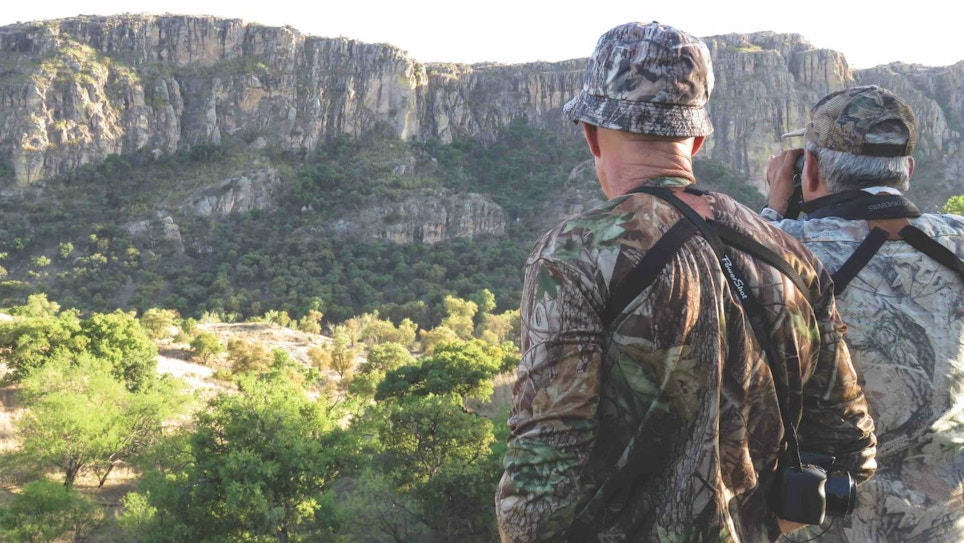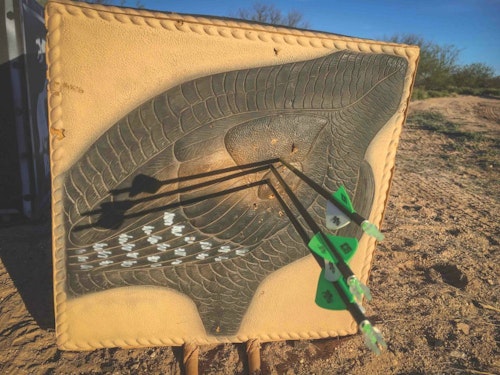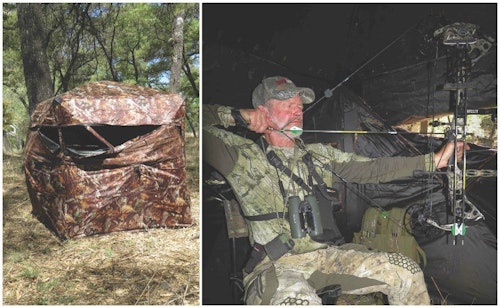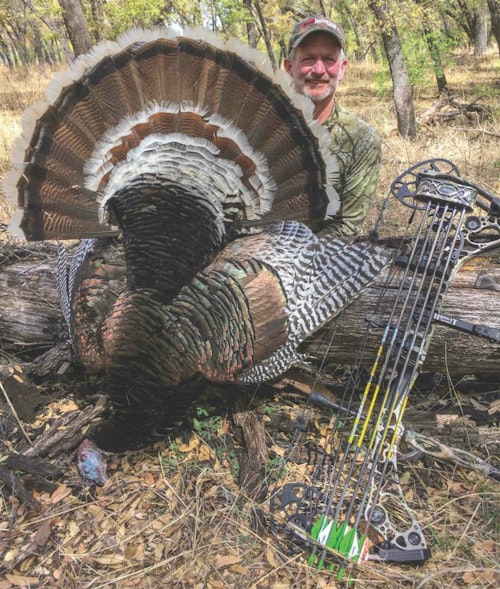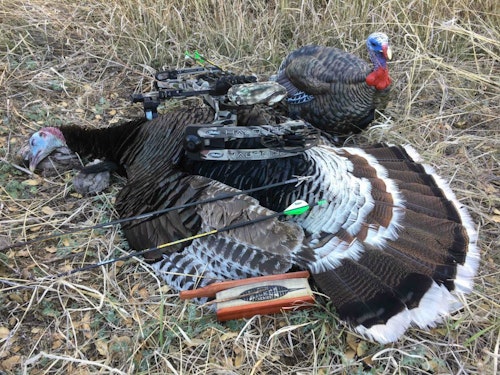I love turkey hunting any way I can get it — especially with my bow. Not quite sure why that is, since when I first started giving it a try back in the 1980s there were no pop-up blinds, and decoys were, to be honest about it, pretty awful. Instead we hunted them the same way we did with shotguns and hoped that we could set up and call a bird into a spot that would allow us to draw the bow without being seen. Which, most times, was like trying to sneak the sunrise past a rooster.
For more than a decade now, I have been bowhunting turkeys with the help of decoys and blinds. Sometimes I use pop-up blinds, sometimes I erect a brush blind. There are times when I simply sit on the ground in some brush, having learned how to draw and shoot my bow from the seat of my pants or from my knees. By having all these options available, I can travel to new places confident I can get a shot if I can get on the birds.
So in early April 2017, when my buddy Patrick Holehan asked me if I wanted to do a DIY hunt for Gould’s turkeys in Sonora, Mexico, I was all in. I love hunting Old Mexico, and have been doing so since the 1970s. Things have changed greatly south of the border since then, when it was much more loosey-goosey. You need access to private property, all sorts of permits for both Mexican and U.S. officials — both of whom can be a royal pain in the you-know-what — and a way to communicate, especially if your Spanish is as rudimentary as mine.
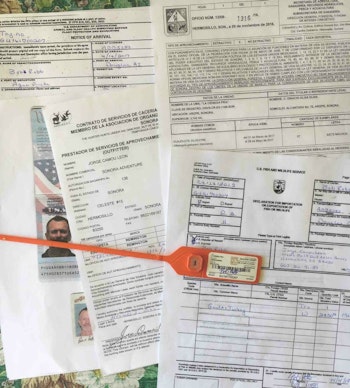
Fortunately Patrick (www.plholehancustomrifles.com), a superb Tucson, Arizona-based custom rifle builder, has also been outfitting Coues deer and Gould’s turkey hunters in Sonora, Mexico, for some 20 years now, often working with long-time Mexican outfitter Jorge Camou. Patrick speaks fluent Spanish, has great connections with Mexican outfitters that, in turn, have the key to the gate to some excellent hunting, and knows the ins and outs of crossing the border with firearms and hunting gear, then returning with the same plus wildlife. So we loaded the truck to the gills and made the 7-hour drive to a ranch that Camou has hunting rights to. The deal was simple. We’d be on our own for the hunting, and pay the landowner for any birds we shot. Patrick hired the same cook he uses for his deer hunts — worth every peso! — and we budgeted 4 days to hunt.
Why Gould’s Turkeys?
The Gould’s turkey is a unique subspecies, found only in the southern portions of Arizona and New Mexico, as well as northern Mexican states of Sonora and Chihuahua. It was first described by J. Gould in 1856 during his travels in Mexico. Like the Merriam’s, the Gould’s is a bird of the mountains. In the United States the Arizona Game and Fish Department, U.S. Forest Service, the Centro Ecologico de Sonora, the National Wild Turkey Federation (www.nwtf.org), and other agencies are working cooperatively to reintroduce a strong Gould’s population first into Arizona and then into other states where suitable range exists. Today a small population exists in southeastern New Mexico.
Gould’s turkeys are the largest of the five subspecies and somewhat resemble the Merriam’s turkey with lots of white plumage, though they have longer legs, larger feet and larger center tail feathers than any of the other North American wild turkey subspecies. Gould’s differ by having distinctive white tips on the tail feathers and tail rump coverts, and their lower back and rump feathers have copper and greenish-golden reflections. They’re drop-dead gorgeous.
Once found throughout southern Arizona, Gould’s turkeys found themselves an easy food source for those who settled and worked in these rugged lands. Between the Civil War and World War I, miners working in southern Arizona harvested Gould’s for many of their meals. By the time Arizona had legal hunting seasons in 1929, Gould’s turkeys had already disappeared from the scene. Currently the Arizona population is growing, and there is good hunting in several of the mountain ranges in the southern portion of the state. All tags are issued through the draw (https://draw.azgfd.com) and competition for them is fierce. As of the end of 2018, my wife and I both had 12 Arizona turkey bonus points, and we’re still waiting to draw a tag.
In recent years, the New Mexico Department of Fish and Game (www.wildlife.state.nm.us) has completed several translocations of Gould’s turkeys from Arizona. New Mexico currently allows two special permits for a Gould’s harvest each year, both allocated through a raffle and an auction. The money raised from these permits is utilized exclusively for the management of Gould’s turkey in New Mexico.
Gould’s populations are very strong south of the border, however, and there are several excellent outfitters such as Camou offering fully guided hunts for them for prices ranging somewhere between $2,000-$3,000, all inclusive, with extremely high success rates.
Let’s Go Hunting!
The trip south was uneventful, except for some time at the border where I needed a Mexican tourist visa and we had to check our shotguns in with the Mexican military. Yes, we took shotguns as well as bows as insurance against totally uncooperative birds. We stopped at the last gas station before entering the ranch and filled both the truck and a half-dozen 5-gallon gas cans so we’d have fuel for both the vehicle and the generator. Jorge met us at the ranch house, we unloaded our stuff, then went out that evening to see if we could roost some birds.
When we planned the trip we knew we were coming a bit early in the season, the risk being that the birds would not yet be gobbling much. We found that to be correct. What we also found in our 3 days of hunting was that, while there were gobblers roosting along a mostly dry creek bed, there were no hens yet in the valley. They would arrive a week or so later, when the breeding season heated up.
We had brought four pop-up blinds and some decoys with us, the initial plan being to get into spots where we heard birds roosting, set up the blinds and decoys, and then, when the world began waking up give a very few soft tree yelps to the gobblers to let them know we were in the area, then wait and see what happened. If that failed us we’d go the run-and-gun route, but that’s much more difficult when bowhunting than when using a shotgun.
My First Morning
The very first morning I was in a spot where within a few hundred yards of where we’d heard a gobbler roost the evening before. The dirt ranch road also had fresh gobbler tracks and wing marks from where a big bird had been strutting. As dawn broke I was greeted by not one, but four, different gobblers sounding off. It was awesome. They pitched down and two definitely walked the other direction. But two birds gobbled close by off-and-on for the next hour, so I yelped encouragement back at them from time to time. Then, silence for 30 minutes.
Just as I was wondering if I’d done something wrong, a bird gobbled right behind my blind. I about jumped out of my chair! Then I saw him, strutting off to my right, in the middle of the road. If he kept coming he’d soon see my decoys.
I had put out three Avian-X dekes painted in Merriam’s turkey colors — Quarter Strut Jake, Breeding Hen and Standing Hen — hoping the white made them look enough like a Gould’s bird to work. That gobbler saw those decoys, walked right over and got nose-to-nose with the Jake, then puffed his body feathers up like a balloon! He postured long enough for me to take a series of photographs, then draw my bow. The broadhead blew through his chest, and just like that, 90 minutes into my hunt, I had my first-ever bow-killed Gould’s gobbler. It was awesome.
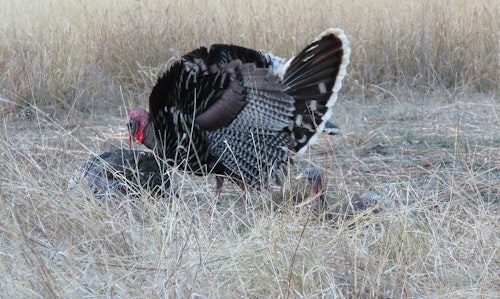
Patrick’s Bowhunt
Patrick was also in the thick of things. We’d set his blind and decoys a mile down the road, near a spot where the creek actually held significant water and there was a lot of tracks and strut marks in the road.
That morning he had three different gobblers come by, but none offered a high-quality shot opportunity. That evening he tried the same blind, but no action. So when we went back there the next morning, there were questions. Would the birds come back? Did he do something to compromise his spot? Should we have moved to another location?
No worries. That morning there was a pair of gobblers roosted close by. They gobbled their heads off in the tree, flew down, then went to a strut zone maybe a half-mile away, where they continued to gobble for the next hour. Then, silence.
We had thought that perhaps it might go exactly like this, but that once they’d done their morning strutting, the birds would come to the waterhole. When they did they’d see the decoys and mosey on over.
And that’s what happened. Two hours after fly-down here came a big gobbler down the road. He saw the decoys, and when he turned to walk in among them Patrick hammered him. And just like that, he had his first-ever archery Gould’s gobbler.
Epilogue
We hunted another day, trying to see if we could make something happen, but could not. We had one big bird come close, but he was a cagey fellow, and didn’t offer a high-percentage bow shot. So we loaded up and headed back home a day early.
Bowhunting Gould’s turkey in Mexico is a very fun and exciting business. I’d done it three other times with a shotgun on outfitted hunts, both in Sonora and Chihuahua, and been successful each time. They are beautiful birds, and the country they live in is some of my favorite in all North America.
Now, if I could just draw that Arizona tag.
Bonus Content: Bringing Your Bird Back
One of the “catches” in doing a DIY Mexico turkey hunt is the hassle in bringing your bird back across the border. First, there are the papers required by the U.S. Fish & Wildlife Service and U.S. Department of Agriculture. There is Mexican paperwork, too. It all has to be done in triplicate. Patrick has dealt with the changing requirements for decades and now brings a computer and his own printer so he can take care of the papers before we reach the border. Also, you must freeze the bird whole (to prevent avian-borne diseases from entering the U.S.) and, within 24 hours, deliver the frozen bird to a taxidermist that has been approved to accept them. Trust me when I tell you there are not a lot of them, so be sure to line one up before your hunt. Expect U.S. Border Patrol agents to closely inspect all your paperwork and your turkey before allowing you to continue on.
In my opinion, it’s almost worth the price of the guided hunt just to have someone else handle this mess.
